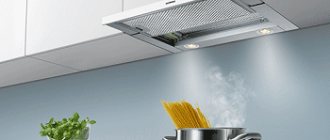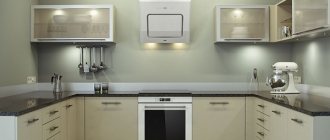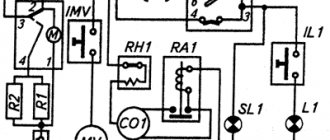In modern houses and apartments, the presence of a spectacular hood above the hob has long become commonplace. And this is no coincidence: in addition to its purely design function, the hood also plays the role of a “cleaner”. Installing a modern kitchen hood gives you the opportunity to breathe air devoid of the tart taste of borscht, cutlets, fried potatoes and other dishes. To the question: “Is it possible to do without a hood?”, we will answer by asking you to imagine a small apartment - a studio in which the kitchen area and living room are combined. If you don’t install a hood in such a studio, then it’s easy to guess what kind of gastronomic air will permeate everything around you. Not to mention your neighbors, who will always be aware of what you are preparing for breakfast, lunch and dinner. To avoid this, we will tell you in detail how and how you can install a hood in the kitchen exclusively with your own hands.
Necessary tool
Before proceeding directly to the process called “Installing a hood,” you need to prepare everything that may be useful for this: additional materials and a tool kit. To comfortably install a hood in the kitchen with your own hands, you must have:
- a hammer drill and a drill (mounting a hood to a wall requires a full set of burs for drilling concrete and tiles);
- screws, self-tapping screws and dowels designed for working with foam concrete, shell rock and porous material;
- screwdriver, hammer and scissors;
- a simple pencil and a triangle;
- level and plumb;
- access to an external outlet, extension cord for working with a hammer drill;
- ventilation corrugation with a cross-section of 150 mm, purchased with a reserve;
- two clamps with the same cross-section, casing and clamps for fastening the casing;
- mounting tape made of polypropylene and a roll of tape;
- grille, for installation on the exhaust vent;
- a mesh that protects against the penetration of insects, birds and bats;
- a stable stepladder or stool;
- an electric jigsaw to make holes in the wall of a kitchen cabinet;
- polyurethane foam and silicone.
Note! Before you begin installing a modern kitchen hood with your own hands, before drilling, it is convenient and practical to build small “pockets” of adhesive tape to prevent crumbs and dust from getting inside the hood.
Installation procedure
It is recommended to begin installation of equipment after the completion of the renovation, when the place for the kitchen set, stove and other furnishings has been determined. In this case, it is easy to mark the location for the air purifier. Before marking, the corrugation or air duct is installed on the ventilation hole, after which the main equipment can be hung.
Using corrugation
This is a flexible corrugated pipe made of aluminum or plastic. It is recommended to use it when the ventilation hole is located directly above the installation site of the hood. Along with the corrugation, the kit should include clamps and a ventilation grille with a mounting flange.
The work order is as follows:
- a grille with a flange is placed at the entrance to the ventilation shaft;
- the corrugation, preferably in an unfolded state, is fixed on the flange with a clamp using silicone sealant;
- in the same way, the lower end of the pipe is attached to the air cleaner flange.
Air duct application
The corrugation is easy to install, but will be too noisy at maximum speed of the ventilation equipment. It is not suitable for use when the barrel outlet is located away from the installation site. In this case, the hood in the kitchen is mounted using an air duct. This is a set of plastic pipes with a round, square or rectangular cross-section.
To extend pipes to the required distance, connectors made of similar material are used. Turns when laying the air duct are made using knees. The design is more rigid than corrugation, produces significantly less noise, and requires fewer additional fasteners with a long routing length. As in the previous case, all connections are made using silicone sealant.
Main device
In addition to the listed design elements, for operational work you will need a set of tools that should be at hand:
- tape measure, building level and marking pencil;
- drill for drilling holes with drills;
- screws, dowels and a screwdriver for final fastening;
- sealant for insulating connections.
After preparing everything you need, you can begin work, which is performed in the following sequence:
- In accordance with the above parameters, markings are made along which a horizontal line is drawn, and points for drilling holes are marked.
- With a four-point fastening, the distance from the lower pairs of fasteners to the upper ones is measured and, using the same tools, a line is drawn with drilling points for the second pair of fasteners.
- If the height of the device is higher than planned, the excess exhaust pipe is cut off.
- According to the markings, the required number of holes are drilled into which the dowels are carefully driven.
- The final fastening with screws is carried out starting from the top pair of fasteners with alignment along the intended horizontal line.
- The work is completed by connecting to the corrugation or air duct.
How to hang a hood over the stove
Distance from the hood to the gas and electric stove.
If the hood is selected correctly, then its width should be either equal to the stove or slightly wider than it. In order to install the exhaust system, it should not only be correctly placed, but also secured. It should be located exactly above the surface of the slab.
Note! The height parameters for installing the hood directly depend on the type of hob. If you have a gas stove , then the distance from the hob to the hood in height should be 75 cm; and if the stove is electric - at least 65 cm. Thus, in order to hang the hood over a gas stove and an electric stove, it is necessary to take into account different distances.
When deciding how to install a hood, before installation, you need to decide on the height, based on the housewife’s height. If a woman stands up straight, the bottom edge of the exhaust system should be slightly higher than her head. We do not recommend setting below this figure. If you set it higher, it won’t be critical.
Good to know! When answering the question of how to properly install a hood above your gas stove, you need to understand the following nuance: if there is a need to install the system higher than 90 cm from the hob, then you need to purchase a hood with increased power.
Let's talk about the topic: “Mounting for a modern hood.” The mounting of the exhaust system depends on its type:
- The built-in kitchen hood should be attached to the surface of a cabinet specially designed for this purpose.
- The hanging system (flat) and the dome (fireplace) hood are attached to the wall surface.
- The island hood is attached to the ceiling surface: upon purchase, the kit always includes clear installation instructions and the entire suspension system.
Cheap and functional!
The cheapest and at the same time popular device is the first option. Here you can find a more functional and productive model. Our tips and recommendations will help you choose a hanging hood. Particular attention should be paid to its size, performance, control methods and additional functions.
Advice! Give preference to models with a corrugated hose. In this case, you will save on replacing carbon filters and increase the performance of the device.
A hanging hood for a kitchen is selected according to the size of the room and the scale of the stove. In a small room where the cooking device has only 2 burners, a compact installation with a width of 50 cm is better suited. For a standard stove with 4 burners, a medium hood of 60 cm is suitable. Owners of a large stove cannot do without an appropriate air purification device with a minimum size of 90 cm.
Calculate the power of the device by multiplying the area of the room by 10.
Dome hood BEST SUN - powerful and quiet
It is good if the system has the following functions:
- Timer to turn off the device after a specified time;
- Residual stroke;
- Ultrasonic humidity level sensor;
- Electric speed switch.
During cooking, lighting of food is important. Choose devices with halogen lamps, they last longer and provide good illumination of the food.
Installation stages
We propose to divide the entire procedure for installing and connecting the exhaust system into three stages:
- Step No. 1 – we install the system taking into account the correct location, which involves fixing it either to the wall or to the ceiling.
- Step No. 2 – connect the hood to the power source. If the outlet is located close, no special problems will arise. If the source of electricity is far away, then you will have to run a wire to it (you can temporarily use an extension cord).
- Stage No. 3 – This stage is required only when your hood model needs to exhaust the exhaust air flow into the ventilation system. You must connect the air duct and discharge it into the ventilation duct.
Installation of a chimney
The kitchen hood is connected to the ventilation duct using corrugated or plastic pipes. The requirements for the air duct are quite important:
- The optimal pipe length for a kitchen hood is no more than 3 m. If the air duct is longer, the efficiency of the device decreases by 10% with each meter.
- Minimum number of bends, adapters and bends. The more knees, the worse the ventilation. The system resistance increases sharply, and exhaust air has difficulty coming out.
- Bends and turns are exclusively at obtuse angles. An angle of 90 degrees reduces efficiency by 10%. The duct should move smoothly from one wall to another.
- Smooth inner surface. In this case, ventilation will be effective, since air resistance will decrease. The best option is round plastic pipes. The corrugated air duct has ribbing, which creates additional obstacles for the outgoing air.
Exhaust pipe installation process - read the instructions carefully
Almost all models of devices are connected to a round air duct made of corrugated or plastic. Rectangular pipes look better as they fit more harmoniously into the space between the cabinet and the ceiling. The diameter may vary, but the cross-sectional area must be at least 0.1 m2. All connections are hermetically sealed to prevent any possible leakage of exhaust air back into the kitchen.
Plastic air ducts are durable, lightweight and do not create additional noise during operation. Corrugated products also have many advantages: they are flexible, lightweight, do not vibrate and do not make noise. But in terms of aesthetics, they are inferior to their plastic counterparts.
The air duct is hidden in the free internal space of walls, furniture or ceiling. In this case, two-level ceilings are convenient: the pipe can be easily hidden above the lower level. If such options are not suitable, use decorative boxes that match the style and color scheme of the kitchen unit or walls. You can make a plasterboard box in the kitchen for the hood with your own hands. Stainless steel kitchen hoods are also on sale.
https://youtube.com/watch?v=Lcr1lSIzEJY
WATCH THE VIDEO
Instructions for installing the exhaust device are included with each model. The combustion hood for the kitchen has detailed instructions with pictures for installing the device. Therefore, you can find a comprehensive answer from the manufacturer to your questions.
Hood installation
When discussing how to install a hood over a gas stove, you should take into account the characteristics of the existing general ventilation.
There are only two ways to remove exhaust air:
- Make a new window to the street.
- Connect the exhaust system with the general building ventilation of the shaft.
It should be recognized that method No. 2 has many disadvantages. This hood requires the installation of a check valve. At the same time, it happens that the supposedly removed air returns to the apartment.
It is much more rational to use an additionally made window for the hood. In order to combat condensate formed inside the system, it is necessary to install a specialized aluminum damper.
Remember! The size of the window under the air duct should have a size corresponding to ¾ of the diameter of the air duct. To tighten the damper, you need to use a special spring that helps it open as air flows through it. This is how the process of self-regulation occurs.
Installing a hood in your kitchen requires taking into account one of the most important functional elements - an odor neutralizer . Today it is presented in three types:
- chemical neutralizer (it needs systematic replacement);
- The neutralizer is electric (it works on the principle of a conventional ionizer, but is capable of creating a larger discharge). The fact is that there is an accumulation of many odors above the hood, unlike in the living room. If a person cooks for a long time, the ionizer will have a detrimental effect on his health;
- ultraviolet neutralizer (it must be taken into account that it requires a systematic procedure for cleaning and replacing lamps). This is the only neutralizer safe for human health. Using ultraviolet light, you can solve two problems at once: purify the air and brightly illuminate the cooking area.
Installing a built-in hood in a cabinet
Let's talk about how to install a hood in a kitchen cabinet on your own. For convenience and clarity, we will divide the process of installing a hood into a cabinet into a sequential algorithm of actions:
- First of all, it is necessary to make an anti-return mechanism in the form of a box. For this you will need either sheet aluminum or galvanized steel. But, it is much more convenient to purchase a check valve for this, which is installed directly in front of the ventilation hole.
Tools required for this : jigsaw, drill and foam, sealant, screws and dowels.
- Then the hood must be installed on the cabinet, and its base must be marked. To cut a hole for a hood in a cabinet, a jigsaw is suitable. First you need to make small holes with a drill, and then cut out the marked shape. This way you can preserve the cabinet, preventing it from being damaged when cutting.
- Then you should install the corrugated air duct inside the cabinet, cut it to the required length and bend it outward.
- After this, the cabinet, with the air duct already installed in it, must be fixed to the wall. To seal all joints, use a silicone-based sealant.
- Then proceed to the process of joining the corrugated sleeve with ventilation. To close all the cracks, using polyurethane foam is ideal, and for small flaws - silicone sealant.
- Secure the hood installed in the cabinet with screws and dowels. Use a clamp to secure it completely.
To install a plastic air duct, we recommend using the same diagram. There is only one “but”: to ensure angles, it will be necessary to use special adapters, and place the pipes with a minimum number of bends (each turn is a loss of 10% of power).
Do not forget! Due to the fact that the kitchen is a place of high humidity, a cabinet made of wood quickly becomes unusable. In this case, the hood should be installed on the wall, without using a cabinet. To do this, you will need U -shaped frame: to make it you need a metal corner.
Having completed all installation work, you should connect the exhaust system to electricity, with the obligatory condition of grounding, and test its operation.
Attaching a wall or dome model to a wall
In appearance, the hoods above the stove of the wall-mounted and dome models are very different from each other, but at the same time, they both must be attached to the wall surface. To do this, their rear housing has four holes: two on each side. In addition, manufacturers supply their products with installation diagrams, installation instructions and templates, with marks for fastening locations.
All you need is to place the industrial template against the wall and make marks (if there is no template, you need to measure the distance between the holes and then transfer it to the wall).
Then everything is much simpler: you need to take a drill and make holes. Insert plastic plugs into them and hang the hood on the dowel - nails, checking the horizontal level of the installed system.
This option is especially suitable if you have a perfectly flat wall, when nothing gets in the way. But, often there is a gas pipe next to the wall, which does not allow the hood to be hung close to the wall.
Take note! If this happens, then nail wooden blocks to the wall. Then attach the exhaust system to them. But, do not forget that over time these bars will become covered with a layer of soot and fat.
There is also a second way to install a hood in the kitchen with your own hands behind the pipes. To do this, you need to use screws - studs (or plumbing studs).
How are these studs attached? They have a thread for screwing into the wall. Their use will allow you to secure the kitchen hood, moving it away from the wall (at the same time, the studs are available in various sizes, and all the nuts are made for a bit or an octagonal wrench).
How to connect the hood to electricity
Due to the fact that the power consumption of hoods is rarely more than 1 kW , it is possible to connect them using standard sockets (preferably with grounding).
With old and dilapidated wiring, you need to ground the wire yourself. You cannot attach it to the surface of water or heating pipes: you can get an electrical injury, not only to your family members, but also to your neighbors (with fatal consequences).
Take note! To pull the grounding wire, you need to go to the panel and find a busbar with wires attached to it, or a pipe to which a stranded wire is screwed. You can also connect your own stranded wire to them (but without touching those that are already installed). For normal operation, the cross-section should be 2.5 mm. The conductor must be stranded copper with a non-flammable sheath.
For ease of installation, many kitchen hoods are equipped with a plug at the end of the wire. They are very easy to connect: you only need an outlet.
But, there are also models whose cord has wires at the end rather than a plug. This is done so that the consumer himself makes the decision on how to connect the system: either using a plug or using a terminal block (by the way, Wago terminal blocks are perfect).
Why purify the air?
Various aromas hang in the air in the kitchen, evaporation occurs, and greasy soot accumulates. As a result, the appearance of a freshly made renovation in a room quickly loses its aesthetic appearance. At the same time, the woman who spends most of her day here breathes in the accumulated dirt and soot. Because of this, her health and well-being suffers. Odors that accumulate in the air cause discomfort during cooking and discourage appetite during meals. You can combat air pollution by frequently ventilating the room or installing an air purifier directly above the stove. The second option is more effective and convenient . Therefore, a device such as a kitchen hood is necessary for normal operation in every modern kitchen.
The hood catches soot, burning, grease and odors during cooking
Air duct for kitchen hood
The palette of air ducts used for kitchen exhaust systems differs greatly in three parameters:
- Material of manufacture.
- Form.
- Hardness level.
Products used to install hoods in the kitchen can be flexible (corrugated) or made of solid, smooth and hard plastic.
Exhaust pipes are made of several types of plastic:
- PVC;
- fluoroplastic;
- polypropylene;
- low-pressure polyethylene.
To connect to the hood, the first three types of plastics listed above are used: they are resistant to high temperatures and have decent rigidity.
Air ducts, in turn, have two types of sections:
- rectangular;
- round.
The rectangular plastic channel has a more compact size, it is easy to disguise it under a suspended ceiling, and it is more convenient to install.
The round shape of the pipes promotes better air passage and has a low noise level.
Air duct sizes for hoods
Do not forget that when buying a PVC air duct, you should also buy adapters . They are needed to connect the plastic tube to the hood. In addition, they are used for air duct bends and the possibility of attachment to the general ventilation system of the entire house. Therefore, if you decide to use corrugation, you can save on unnecessary adapters.
You should know! The length of the PVC pipe should not be more than three meters . Otherwise, the performance level of the exhaust system will decrease with each additional meter of its length. Each piece of bend also has a bad effect on the performance of the hood, so you should try to avoid ninety-degree angles . You can make no more than three bends and bending points .
The diameter of the plastic pipe should be selected strictly according to the cross-section of the ventilation hole:
- The size range of rectangular and square PVC air ducts has standard sizes. The most commonly used sizes are: 110 X 55, 120 X 60 and 204 X 60 mm;
- indicators of round plastic pipes: from 110 to 150 mm. (diameter).
How to attach corrugation to the hood and ventilation
If you intend to install a hood using an aluminum corrugated hose, then you need to decide on the method of attaching it to the body and to the ventilation. For this purpose, you need to purchase a clamp of the required size (there are metal and plastic).
In addition to the clamp, a special ventilation grill with a hole at the top for connecting the air duct tube is useful. At the bottom it has a hole to remove “dirty” air from the kitchen using natural circulation during the time the exhaust system is not functioning.
Note! To secure the corrugation, you need to use a grille with a protrusion: in this case, a small side surrounds the hole. It is on this that the corrugation is put on, and then it is secured with a clamp of the required size. The corrugation should also be secured to the hood: also using a protrusion.
How to attach an air duct to walls
Plastic air ducts have special fasteners in the form of a latch. They are first mounted into the wall using dowels. Most often, only one fastening is sufficient for an area of up to 60 cm. It is into these latches that pipes are inserted during installation, with little effort.
When you want to attach to the ceiling , use exactly the same fasteners. If it is necessary to maintain a certain distance from the ceiling, this type of fastening is not suitable. Then you will need to take perforated hangers (plasterboard), fix them to the ceiling, and then attach the PVC air duct to them with small screws.
The corrugated air duct should be secured to the wall using a clamp or plastic ties.
Where and how to remove the air duct
As a rule, the air exhaust system from the hood is carried out into the ventilation hole (this is where the natural process of general house ventilation takes place, and draft is present).
But this is not a competent approach, because a significant part of the grille turns out to be closed by the air duct, and a full exchange of air mass is not possible through the remaining tiny hole.
You should know! Installing a hood in the kitchen requires connecting the air duct to a separate channel dedicated to it.
- If there is a separate channel, the same grille as in the photo should be installed on the hole:
- When installing a hood in the kitchen on your own, if there is no separate channel, but there is an outer wall nearby, you will have the opportunity to route the pipe to the street side by placing a grille outside.
These are the two main methods of installing well-functioning ventilation with a long period of operation.
How to take it outside
First of all, in order to bring the air duct into the wall, you need to make a hole in the wall. It is the production of the hole that is the main difficulty of this work.
When the hole is ready, you need to insert the “body” of the air duct into it, and close the remaining gaps with a solution. From the outside, the hole must be covered with a grill (to prevent dirt, unnecessary objects, birds, etc. from getting into it).
To prevent street air from blowing into the apartment, it is necessary to install a check valve - in the figure below we have indicated it with a beveled line:
If you carefully examine the picture, you will notice that the non-return (non-return) valve is a light plate made of plastic or metal. It is fixedly fixed at two points to the pipe (top and bottom), and the “petals” are supported by a weak spring.
When the exhaust system is not working, the valve blocks the access of air masses from the street. As soon as the hood is turned on, the plate, thanks to a spring, returns to its place.
Remember! If you decide not to install a check valve, then in winter the kitchen will be very cold due to the icy outside air entering the apartment.
So that the hood does not interfere with natural ventilation in the kitchen
Using a regular tee and check valve, you can install the exhaust system in such a way that it cannot interfere with the natural ventilation of the kitchen area. To do this, it will help you:
- specialized ventilation grille;
- presence of a check valve;
- the presence of a regular tee.
How should this be installed? You must attach a tee to the ventilation grille: connect the air duct from the hood to its lower inlet, and install a check valve on the free outlet so that it closes when the air flow passes from the pipe, as shown in the picture:
Let's talk about how such a system functions.
When the hood is at rest, the “petals” of the valve are bent, and the air flow from the kitchen area enters the ventilation duct, passes through the grille and the open outlet of the tee.
As soon as the system is turned on, the air flow from the hood rotates the valve plate, and the air flow enters the ventilation system. When the hood is turned off, the springs again open the passage of air through the tee.
Take note! From the outside, such a system is not entirely attractive, and, of course, it should be disguised. But, it is the only way to connect the hood to the only existing ventilation outlet, while maintaining air exchange.
Output to the ventilation duct
In many modern panel houses of various series, you can often find both separate and combined ventilation ducts. To find out which ventilation duct is in your home, you should contact your service company for information.
You should know! If you can smell food from your neighbors in the house, it means there is a single network in your house. Then connecting your exhaust system to this single network will automatically complicate life for your neighbors below.
Many modern hoods are capable of operating in various power modes. If there is a single ventilation duct in the house, you should not turn on the hood at full power.
By connecting the exhaust system to a single exhaust duct, you will deprive your kitchen of natural ventilation. It will be possible to install a special combined grid, but it will not be able to solve the problem entirely. The fact that there is natural ventilation when the hood is not working will not go away, but the quality of the exhaust system will sharply decrease: the removed air will be able to flow back to you.
Important note! It is better not to occupy the natural ventilation channel, but to vent the hood to the street through the outer wall of the house.
What will the gas service say?
Most standard range hood models can be used equally successfully for both electric and gas stoves. The only difference is at what height the air intake diffuser is installed. For a gas stove, the optimal height for mounting the housing is at least 70 cm; above the electric stove, the hood is raised by 55-60 cm.
Before you install a brand new hood in your kitchen, you need to take into account the fact that the correct installation will be checked by representatives of the gas service during the annual inspection of ventilation systems. To avoid claims from the gas company controller, it is enough to comply with two conditions when installing the hood:
- The diameter of the exhaust air ducts connecting the housing and the main ventilation duct must be at least 150 mm;
- The air duct outlet should be connected only to the air well, but in no case to the outlet of the exhaust pipe from the gas water heater or heating boiler;
- The best option would be to install a hood and connect the air duct to the central exhaust pipe while maintaining the existing window for natural supply and exhaust ventilation, as in the diagram.
Installation of such a structure will require the use of an adapter block with a clapper valve on the natural ventilation window. The structure will be somewhat more cumbersome, but the use of a double circuit allows you to maintain the microclimate in the kitchen, even if the hood fan is turned off or de-energized. According to gas workers, such an installation fully complies with the safety criteria when working with gas equipment, since even if there is a gas leak and the windows are tightly closed, the gas will be safely removed from the kitchen area.
For an electric stove, perhaps a more interesting solution would be a recirculation or convector hood. Thanks to a special circuit, the air is simply cleaned of vapors, grease and water and returned to the kitchen area. During its installation, there is no need to install a complex and cumbersome air duct system; it is enough to periodically clean the mesh and change the carbon filter.
Summary
Having chosen a hood by carefully selecting it to match the color and design of the kitchen unit, you are faced with a choice: turn to professionals for help in installation, paying a substantial fee for installing a kitchen hood; or hang it yourself, after reading our article.
The most important thing when installing a kitchen hood is: objectively assess your strengths and the possibility of receiving help from household members; evaluate the instrumentation before starting work; understand the instructions included with the hood and believe in yourself.
Attaching a wall or dome model to a wall
These models are widespread because they have a simple design and are suitable for installation in small kitchens. Connecting kitchen hoods of wall-hung and dome types is done in a similar way. They are mounted on the wall. These models have 4 holes on the back wall for hanging the device. In most cases, manufacturers include a special stencil for both wall-hung and dome hoods, which indicate the location of the fastening elements.
First you need to measure the distance from the stove to the location of the hood with a tape measure. After this, using a level, you need to draw an even horizontal line along the measured point, which will act as a limiter. The lower part of the body should be located along this mark. After this, using a stencil you need to apply marks for fasteners. We make holes in the marked places with a puncher or drill. Plastic plugs for dowels are inserted into them and screws are screwed in.
Be sure to measure the height of the device. If necessary, it is necessary to shorten the upper part of the pipe, since the body of the device should not fall below the previously drawn stop. After this, the hood is mounted on the wall and fixed. Then the air duct is attached.











